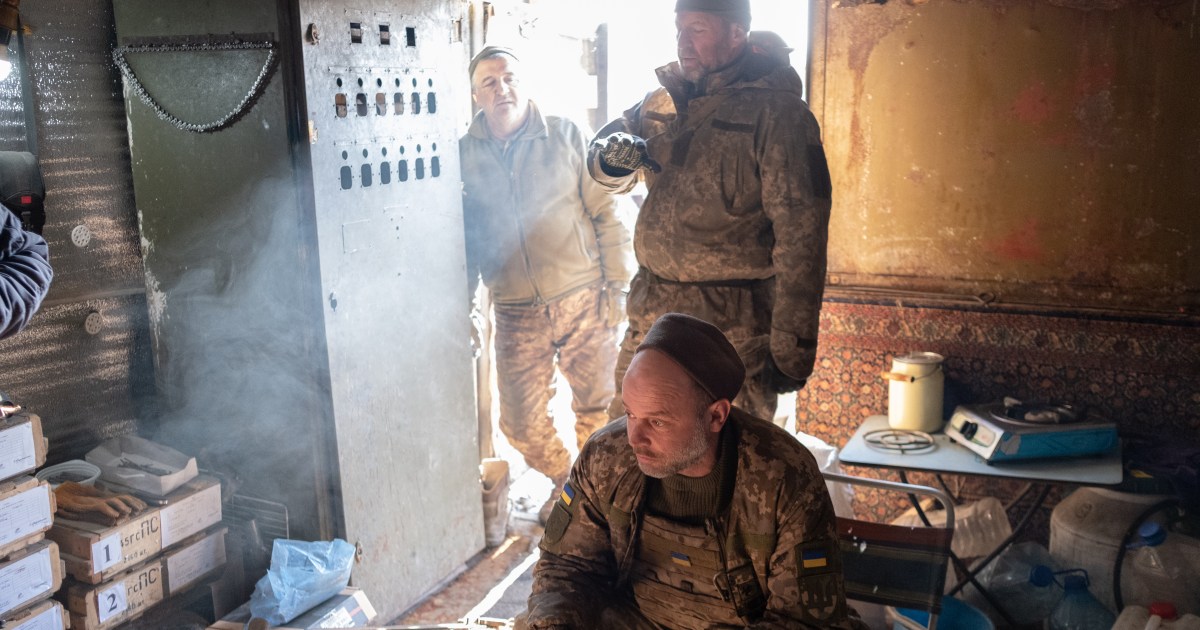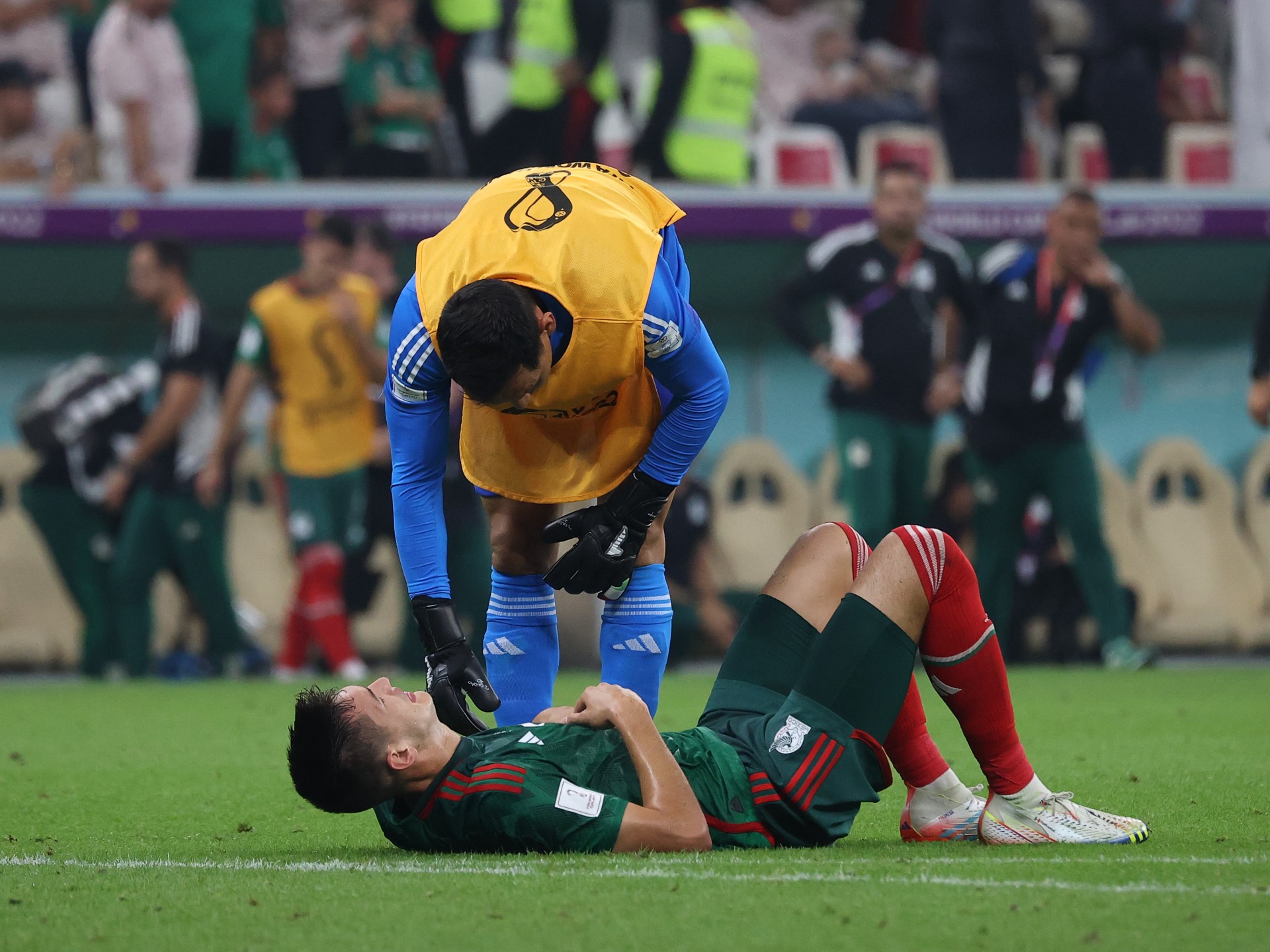‘There’s always danger’: Preparing for war on Ukraine’s front line | Ukraine-Russia crisis News
First names have been used in some instances to protect identities.
Pisky, Popasna and Bakhmut, Ukraine – Krim takes a long puff of his cigarette as he pulls up a stool in a makeshift officer’s mess.
Sunlight pours through the doorway as soldiers pass by each other with bowls of homemade soup.
Outside, perched on a network of trenches, a young soldier called Igor peers through a periscope as dogs pace past him.
The peaceful atmosphere masks a very real danger; just a few hundred metres away, Russian-backed separatist snipers have their sights trained on this very position.
“For the Russian snipers, the east of Ukraine is like a training camp,” said Krim, who uses a nom de guerre.
After lunch, he heads back into the trenches, being sure to stay below the high muddy walls; as he reaches a clearing, he motions for everyone to run; it is clear skies today, which makes them easy targets.
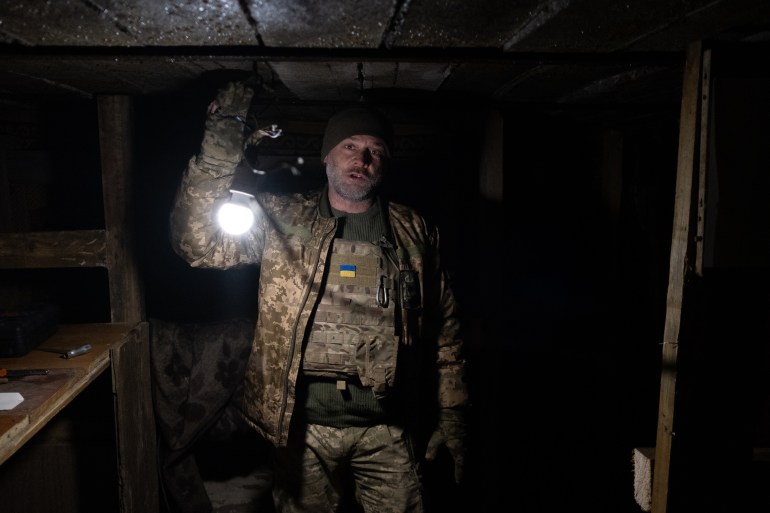 Krim, a soldier, pictured in a newly dug section of the trenches on the front lines [Nils Adler/Al Jazeera]
Krim, a soldier, pictured in a newly dug section of the trenches on the front lines [Nils Adler/Al Jazeera]In recent months, Russia has amassed more than 100,000 troops along its borders with Ukraine spurring fears that Moscow could launch an invasion. The US has responded by threatening economic sanctions and has placed 8,500 troops on heightened alert to deploy to Europe. In addition, NATO has reinforced its eastern borders with warships and fighter jets.
Moscow denies it is planning an attack and blames NATO for undermining the region’s security.
But Krim and his fellow soldiers cannot afford to be distracted by changes in political tensions; their job remains the same as it has for the last few years.
“There are no big changes; we don’t see any new attacks or invasions,” said Krim. “Here, there is always danger.”
Alexander, a hulking soldier draped in winter camouflage crouches in a hidden observation post buried in the side of a hill. He stares through a long pair of binoculars; every few days he spots a separatist, but most days he will just look out at the same frozen expanse.
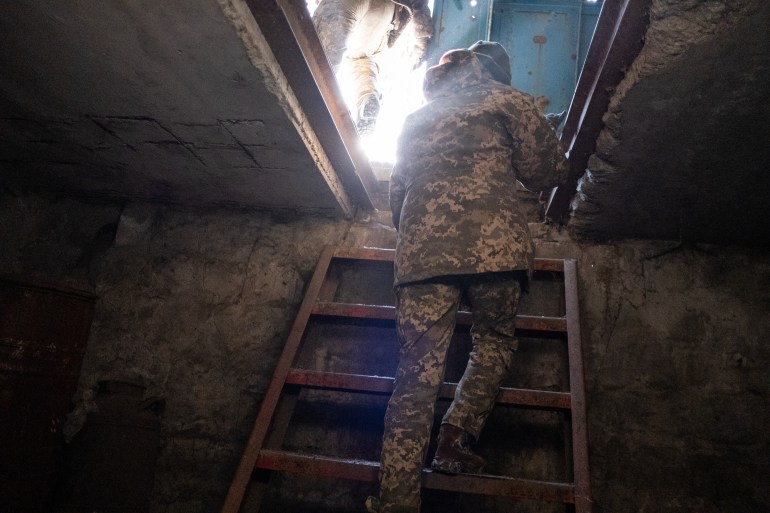 A bunker in the trenches near Donetsk [Nils Adler/Al Jazeera]
A bunker in the trenches near Donetsk [Nils Adler/Al Jazeera]In the distance, sit the scorched ruins of Donetsk International Airport, the sight of two violent battles that raged for over three months and left hundreds dead.
To break the monotony of tactical trench warfare, many soldiers develop skills like welding, plumbing or cooking, creating a relatively comfortable infrastructure in the camp.
Some of the rooms, usually belonging to soldiers who have served the longest, are homely, furnished with pictures, self-made cupboards, and comfy beds. Others are just a simple wooden surface with a couple of blankets.
 Igor, a soldier, observes the movements of Russia-backed separatist forces [Nils Adler/Al Jazeera]
Igor, a soldier, observes the movements of Russia-backed separatist forces [Nils Adler/Al Jazeera]The six-month rotations can be unbearable for soldiers with families.
Cristina has served in the army for four years and has two young children at home; “I can’t even speak about them right now,” she said, visibly emotional.
Behind the network of trenches in the charred chaotic rubble of a village destroyed by fighting in 2014-2015 sits a temporary communications centre.
Here, out of the sight of snipers, flak jackets and helmets are taken off, but it is still several kilometres before the red zone – an area closed off to civilians – comes to an end.
It is hard to imagine that even the most dogged resistance from these soldiers on the front line would be able to stave a full-scale attack from Russia.
But Dzhemil Izmailov, the commander of a mechanised infantry battalion in the 23rd Brigade, believes that the Ukrainian Army would withstand an invasion due to extra layers of defence located in the surrounding territory.
“These would be very hard to break through,” he said in a confident tone, “and we can also rely on anti-aircraft protection.”
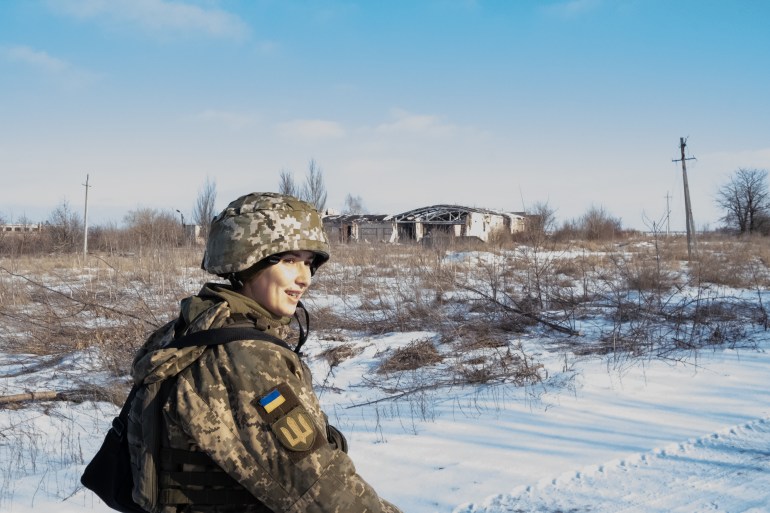 The latest tensions have brought back memories of 2014, when Russia annexed Crimea [Nils Adler/Al Jazeera]
The latest tensions have brought back memories of 2014, when Russia annexed Crimea [Nils Adler/Al Jazeera]Krim is also comforted by his belief that the UK and other countries will help Ukraine.
He takes out his phone to show pictures of him hugging a British officer during a joint training exercise in 2021; “I feel the West’s support.”
A mannequin dressed as a soldier and carrying a scythe sits slumped at the edge of the red zone, a grim reminder of the death and destruction this conflict has brought to the area.
But outside in the villages and towns and villages surrounding the front line, everything seems remarkably calm.
In Bakhmut, a city in the Donetsk Oblast, memories of the fighting that came within a few kilometres of its outskirts remain imprinted in the local population.
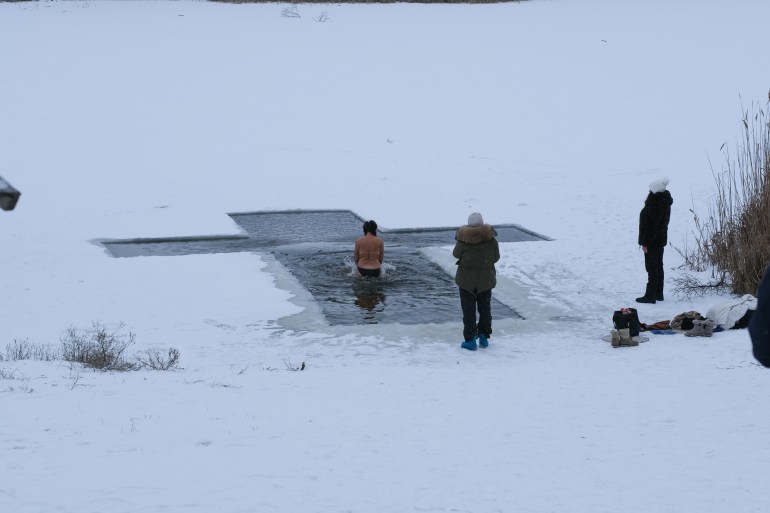 Olga, Alyana and Lubouf live near to the front line but have learned to dissociate with the conflict [Nils Adler/Al Jazeera]
Olga, Alyana and Lubouf live near to the front line but have learned to dissociate with the conflict [Nils Adler/Al Jazeera]Residents Olga, Alyana and Lubouf, three women in their forties who described themselves as entrepreneurs, recalled the fear they felt when they heard shelling, but remained unconvinced by the latest escalation of tensions.
“We saw Ukrainian soldiers, dirty and skinny begging for bread; crying on their knees because of what had happened,” said Olga.
“We don’t believe in this threat; we think this is a political thing.”
The women’s priority is now to look after their health, something they are doing today with some cold-water therapy in a local lake.
In Popasna, a village that experienced heavy fighting and a brief occupation by Russian-backed separatists, locals in a funeral home dismiss current crisis as political hot air.
“We know how the internet works!” said Svetlana with a flick of the wrist, adding she had friends on the separatists’ side who she talks to via Skype
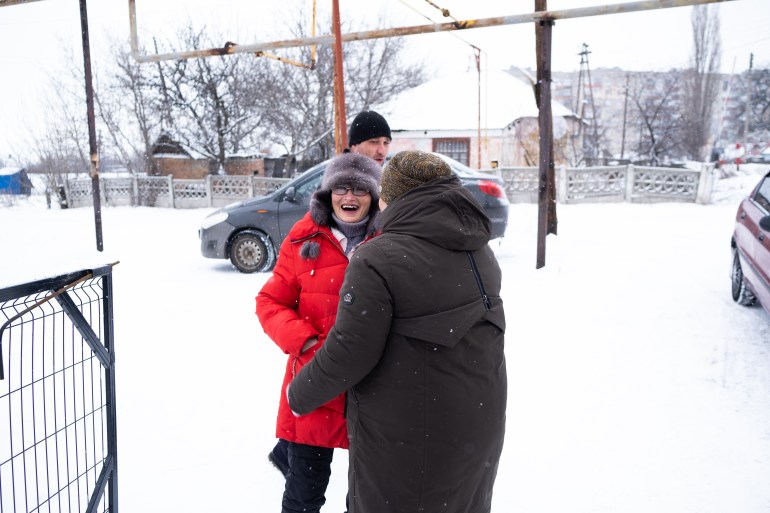 Life goes on for locals in Popasna [Nils Adler/Al Jazeera]
Life goes on for locals in Popasna [Nils Adler/Al Jazeera]But many locals also speak of a latent anxiety that is kept at bay by coping mechanisms developed over years of living within earshot of heavy shelling and sporadic gunfire.
Carolina, a nine-year-old girl from Popasna, vividly remembers the explosions that fell near her house a few years ago.
“I was sitting in the corridor and crying out of fear,” she said.
Her school is teaching children what to do if Russia attacks.
“We know to leave altogether, but never to take any clothes, or bags that don’t belong to us in case they are mines,” she said.
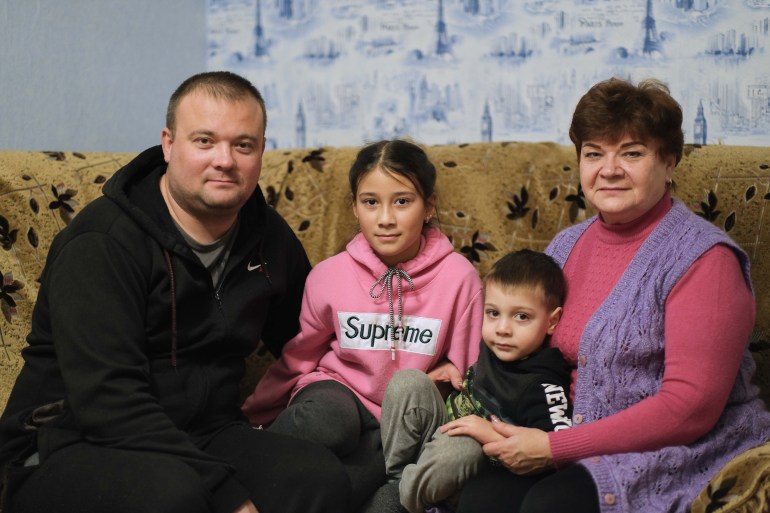 Carolina, second left, remembers the bombing near her family’s house in 2014-2015 [Nils Adler/Al Jazeera]
Carolina, second left, remembers the bombing near her family’s house in 2014-2015 [Nils Adler/Al Jazeera]Her grandmother, Vera Grigorjevna, describes how she is always anxious about an invasion but has learned to create a “self-assured mode” focusing on everyday life.
Grigorjevna, her son and her grandchildren have all practised what to do in the event of an invasion. They know exactly what documents they would need and the best escape route.
Snizhana Matkovskaya, originally from Crimea, was temporarily living in Popasna when the last war broke out and has since opened a restaurant that caters to soldiers who pass through.
“I felt such pity for the place, so I stayed,” she said.
Recently, Matkovskaya attended sessions with a psychologist that helped her to see her situation as abstract. She – and others who took part – now take things one step at a time.
“If you live in such fear, you will get sick,” she said.
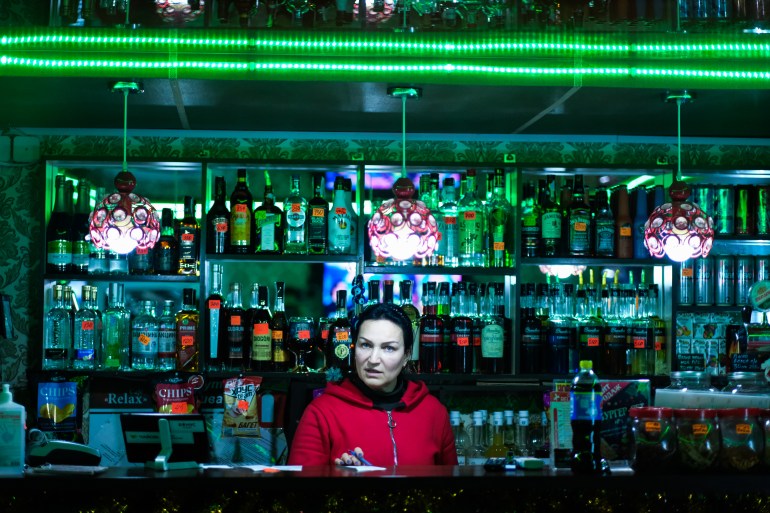 Snizhana Matkovskaya runs her own café in Popasna, near the front line [Nils Adler/Al Jazeera]
Snizhana Matkovskaya runs her own café in Popasna, near the front line [Nils Adler/Al Jazeera]
